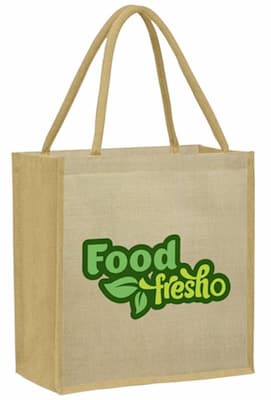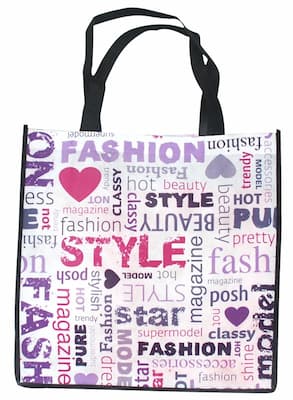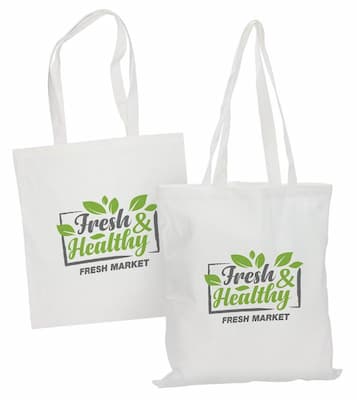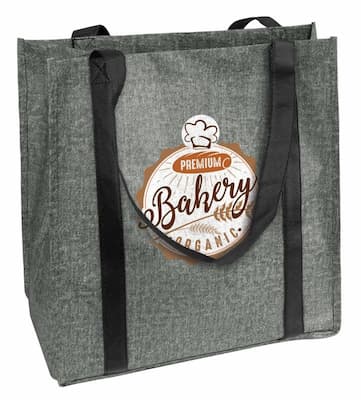
26 October, 2023
Green Branding: Eco-Friendly Materials Changing Promotional Bags
The world today is more environmentally conscious than ever before. As brands compete for the attention of discerning customers, promotional strategies are transforming. One of the most noticeable shifts is in the realm of promotional bags. Gone are the days when brands could get away with doling out plastic totes en masse. The new era belongs to eco-friendly materials promoting the brand and emphasising its sustainability commitment. This article explores how these materials are revolutionising the promotional bags industry.
1. Cotton and Canvas: Natural and Durable

When it comes to promotional bags, cotton and canvas have long been revered for their versatility and enduring appeal. In recent years, however, the appeal of these materials has transcended beyond their functional utility.
Cotton, a soft white fibrous substance, is derived from the cotton plant, while canvas, a strong, coarse, unbleached cloth, is made from hemp, flax, or cotton. Their plant-based origins give them a unique selling point in an age where sustainability is paramount. Being biodegradable, these materials decompose over time, causing no long-term harm to the environment, unlike synthetic materials that can persist for centuries.
The ruggedness of canvas and the soft, flexible nature of cotton makes bags made from these materials exceptionally durable. Whether it's a trip to the grocery store, a day at the beach, or an afternoon in the city, these bags can withstand a variety of conditions without wear and tear. Their longevity means that consumers won't need to replace them frequently, contributing to reduced waste.
With the rise of eco-conscious consumers, brands are under pressure to produce quality products and ensure their products align with sustainable values. Cotton and canvas bags offer the perfect canvas (pun intended) for this. The smooth texture of these materials is ideal for printing, allowing brands to easily imprint their logos, slogans, and other designs. The result? A functional, eco-friendly bag that doubles as a mobile advertisement.
While they were once seen as purely utilitarian, they are now making waves in the fashion world. The simplicity of their design serves as a backdrop that can be jazzed up with vibrant colours, patterns, or chic minimalist designs. A cotton tote, for instance, can be as much a fashion accessory as a handbag or clutch. The shift from utility to style and their eco-friendly properties make them a win-win in the modern consumer market.
2. Jute: The Golden Fibre

Jute stands out as a shining star in the diverse realm of eco-friendly promotional materials. Often dubbed the 'Golden Fibre', jute boasts a rich, golden hue and offers many functional and environmental benefits. As brands increasingly pivot towards sustainable choices, jute is emerging as a favourite, blending aesthetic appeal with an eco-friendly ethos.
Originating from the stem and outer skin of the jute plant, this fibrous material is predominantly cultivated in warm, humid climates, especially in regions of Asia. Its natural abundance and ease of cultivation make jute a cost-effective choice, a factor that lends to its 'golden' moniker beyond just the colour.
Its environmental credentials are impeccable. As a vegetable fibre, it is fully biodegradable, meaning that products made from this material will naturally decompose over time, leaving no trace behind. Additionally, it is recyclable. If a jute product reaches the end of its lifecycle, it can be processed and repurposed, ensuring minimal waste. Moreover, the cultivation of it has added environmental benefits. The plants are known to absorb large amounts of carbon dioxide and replenish the soil, making its cultivation a boon for biodiversity.
From a design perspective, it offers a unique blend of rustic elegance. The naturally rough and textured appearance of these bags provides a distinct aesthetic, a far cry from the smooth finish of synthetic materials. This textured finish not only provides a tactile experience but also serves as a visual reminder of the bag's natural origins. Brands using it for promotional materials can leverage this rustic charm, offering eye-catching and eco-friendly products.
It can also be dyed in various colours, interwoven with other materials for added strength or aesthetic appeal, or treated to achieve different finishes. This adaptability means that brands have a wide canvas (or should we say, a wide jute sack) to play with, tailoring designs to align with their brand image while retaining the eco-friendly benefits.
3. Recycled PET (rPET): Giving Plastics a Second Chance

In a world of plastic pollution, innovative materials like recycled PET (rPET) emerge as a beacon of hope, paving the way for sustainable solutions. rPET bags, crafted from repurposed plastic bottles, stand as a testament to the potential of giving discarded items a renewed purpose. By championing rPET, brands adopt a circular economy model and make a bold statement about their commitment to ecological responsibility.
The journey of an rPET bag begins long before it reaches a consumer's hand. Discarded plastic bottles, which could have otherwise ended up in landfills or the oceans, are collected and processed to extract PET. This recovered PET is then cleaned, melted, and spun into yarn, which serves as the primary material for producing the bags. This transformative process underscores a pivotal shift in how we view waste — not as an endpoint, but as the beginning of a new lifecycle.
While the recyclable nature of rPET is its standout feature, its benefits extend further. They are durable, often boasting a strength comparable to their virgin plastic counterparts. This means that while they stem from recycled sources, they don't compromise on quality or longevity. Furthermore, the process of recycling it typically consumes less energy than producing virgin plastics, leading to reduced carbon emissions.
Every one of these bags in circulation is a tangible reminder of the strides being taken against plastic pollution. For brands, using them isn't merely a promotional strategy; it's a reflection of a deeper ethos. By opting for them, they send a clear message about their stance on environmental issues and their active role in addressing them.
It isn't just another promotional item for consumers - it's a symbol. It signifies the brand's dedication to innovation, sustainability, and a future that harmoniously blends commerce with conservation. When brands choose rPET bags as promotional items, they're not just offering a product but telling a story of resilience, innovation, and hope.
4. Bamboo Fibre: The Sustainable Superstar

Bamboo fibre stands tall in the vast landscape of eco-friendly materials, embodying sustainability in its truest sense. As the world increasingly leans towards green solutions, it emerges as a frontrunner, presenting a blend of ecological benefits and aesthetic appeal. Bags made of bamboo fibre signify more than just an accessory; they represent a brand's commitment to environmental conservation and a brighter future.
The magic of it lies in its growth rate. This resilient plant can shoot up at an astonishing pace, with some species growing up to 3 feet in a single day. This rapid renewability ensures a continuous supply of raw material without the need for replanting, reducing land degradation and ensuring soil health.
One of its remarkable aspects is its inherent resistance to pests. This natural immunity means it can flourish without harmful pesticides, eliminating the risk of chemical run-offs contaminating water sources. By opting for pesticide-free bamboo fibre, brands underscore their commitment to protecting the environment and consumers from harmful chemicals.
Beyond its eco-credentials, it brings a unique tactile experience. Its natural texture is both soft and durable, ensuring that bags made from this material are long-lasting while offering a distinctive touch that sets them apart from standard alternatives. The inherent strength of the fibres makes these bags resilient, ensuring they endure the daily wear and tear with grace.
For brands, a bamboo bag is more than just a promotional tool — it's a statement. Choosing it signals a keen awareness of the planet's needs and a proactive approach to addressing environmental challenges. Such a choice resonates with a growing demographic of eco-conscious consumers, who are on the lookout for brands that align with their own values of sustainability and responsibility.
5. Non Woven Polypropylene Bags

At the heart of the non-woven bag's appeal is its unique construction. Unlike traditional textiles, non-woven fabrics are produced by binding fibres together through chemical, mechanical, heat, or solvent treatment. This production method results in a durable and lightweight material, making it perfect for promotional tote bags.
They require less energy during the production phase compared to their woven counterparts. This reduction in energy consumption translates to a lower carbon footprint, making them a green choice from the get-go.
They are LAO designed for reuse. Their durability ensures they can handle the rigours of everyday use, encouraging users to keep them for longer. And when they do reach the end of their lifespan, many non-woven bags are recyclable, ensuring they don't end up in landfills. The need to phase out single-use plastics has never been more urgent. These present a compelling alternative, marrying the convenience of plastic bags with the eco-friendliness of sustainable materials.
They also offer a broad canvas for branding, both in terms of size and design flexibility. However, the real power lies in the message they convey. Brands that opt for non-woven bags as promotional materials align with the global sustainability movement. This resonates with environmentally-aware consumers and positions the brand as a responsible and forward-thinking entity.
With the rise of eco-fashion, they have transitioned from simple grocery carriers to stylish accessories. The material's versatility means it can be moulded into various shapes, sizes, and designs. From chic totes to practical backpacks, non-woven bags are making waves in the fashion scene, giving brands an edge in the competitive promotional market.
Conclusion
The shift towards eco-friendly promotional bags is more than just a trend. It represents a collective move towards responsible consumerism and branding. As companies align their promotional strategies with sustainable practices, they create brand visibility and foster brand respect and loyalty. By choosing eco-friendly materials, brands can convey a powerful message: that they care about our world and are doing their part to safeguard it for future generations.
The Promotional Bags Team

